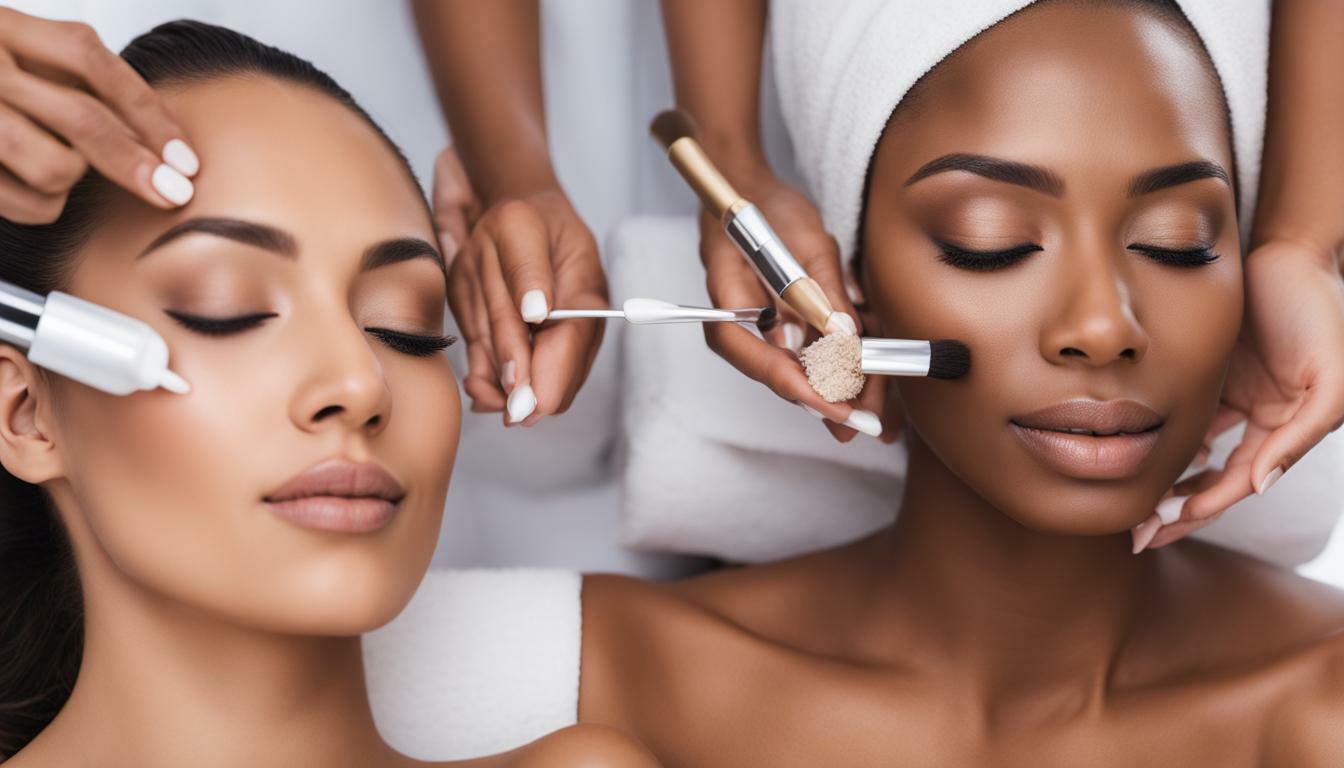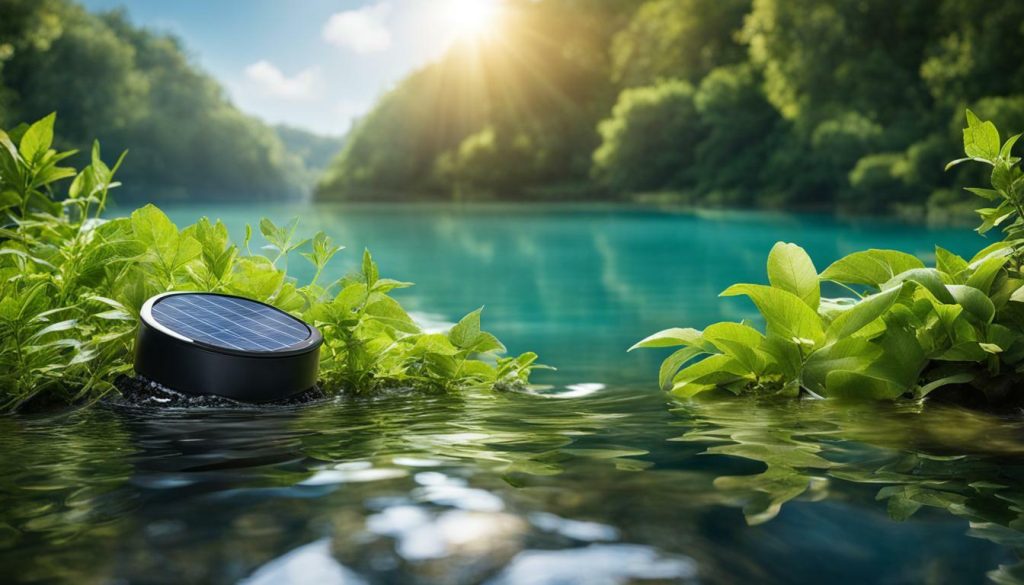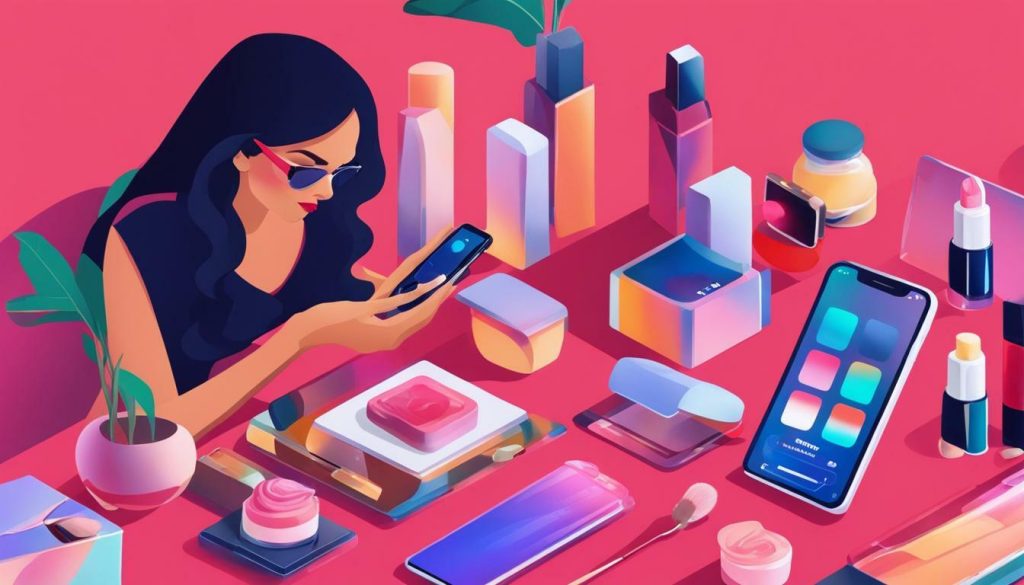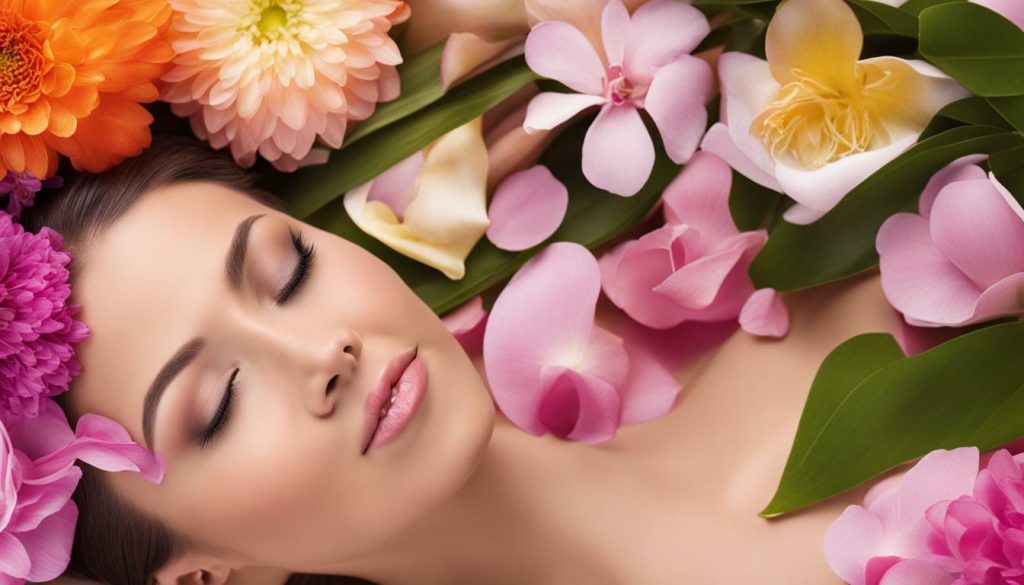
The esthetician industry in the United States is experiencing significant growth and undergoing various trends that are shaping the beauty market. As the beauty market as a whole continues to thrive, it is projected to reach a value of $580 billion by 2027. The growth rate of premium beauty products is expected to outpace that of mass beauty products, with consumers increasingly seeking high-quality and innovative options. Furthermore, the rise of e-commerce has revolutionized the beauty industry, providing consumers with convenient access to a wide range of products.
Key Takeaways:
- The beauty market in the United States is projected to reach $580 billion by 2027.
- Premium beauty products are expected to have a higher growth rate than mass beauty products.
- E-commerce is playing a significant role in the accessibility and convenience of beauty products.
- The demand for estheticians is high, with job growth projected at 17% from 2018 to 2028.
- Consumers are increasingly seeking personalized beauty experiences through the use of AI and AR technologies.
Growth and Projections in the Beauty Market
The beauty market in the United States is resilient and is projected to reach a value of $580 billion by 2027, with premium beauty products expected to outpace mass beauty products in growth. This growth is fueled by factors such as rising disposable income, increased consumer awareness about personal grooming, and the growing popularity of beauty and wellness trends.
According to industry reports, the premium beauty segment is predicted to grow at a faster rate compared to the mass beauty segment. Consumers are increasingly willing to spend more on high-end products that offer superior quality, innovative formulations, and targeted solutions for their specific needs. This trend is further reinforced by the growing influence of beauty influencers, celebrity endorsements, and the desire to achieve flawless skin and a youthful appearance.
E-commerce has become a key driver of growth in the beauty market. With the convenience of online shopping and the increasing availability of beauty brands on digital platforms, consumers are now able to access a wide range of beauty products from the comfort of their homes. Online beauty retailers offer competitive pricing, attractive discounts, and personalized recommendations based on individual preferences, making it easier for consumers to discover and purchase their favorite products.

| Year | Market Value (in billions) |
|---|---|
| 2021 | 450 |
| 2022 | 490 |
| 2023 | 520 |
| 2024 | 550 |
| 2025 | 570 |
| 2026 | 580 |
| 2027 | 580 |
“The beauty market in the United States is on a steady growth trajectory, driven by the increasing demand for premium beauty products and the convenience of online shopping. As consumers continue to prioritize self-care and invest in their personal well-being, the beauty industry is poised for further expansion in the coming years.”
As the beauty market evolves, staying informed about the latest trends and consumer preferences becomes crucial for industry professionals and businesses. Adapting to the changing demands and embracing innovation will be key to success in the competitive beauty landscape.
Demand for Estheticians: Job Outlook
The demand for estheticians is high in the United States, with a projected job growth rate of 17% from 2018 to 2028. Currently, there are over 48,000 estheticians employed in the country, and there are more than 3,700 active job openings. This growth can be attributed to various factors, including the increasing popularity of skincare and beauty treatments, as well as the expanding range of services offered by estheticians.
Estheticians play a vital role in the beauty industry, providing skincare treatments, facials, hair removal, and other specialized services. They are trained professionals who have in-depth knowledge of skincare products, techniques, and technologies. As consumers become more conscious of their appearance and seek personalized beauty experiences, the demand for skilled estheticians continues to rise.
With the rising demand for estheticians, there are plenty of opportunities for individuals interested in pursuing a career in this field. Estheticians can work in various settings, such as spas, salons, dermatology clinics, and wellness centers. They can also choose to work independently or start their own businesses.
| Key Takeaways |
|---|
| Projected job growth rate of 17% from 2018 to 2028 |
| Over 48,000 estheticians currently employed in the United States |
| More than 3,700 active job openings for estheticians |
Table: Esthetician Job Outlook
Estheticians provide essential services in the beauty industry, and the demand for their expertise is expected to continue growing. The table below summarizes the job outlook for estheticians in the United States:
| Job Outlook | Statistics |
|---|---|
| Projected Job Growth Rate | 17% (2018-2028) |
| Number of Employed Estheticians | 48,000+ |
| Active Job Openings | 3,700+ |
“As the beauty industry continues to expand and consumers seek personalized skincare treatments, estheticians are in high demand. This career path offers a range of opportunities for those passionate about helping others look and feel their best.”
As the esthetician industry continues to evolve, it is essential for professionals to stay updated on the latest skincare trends, techniques, and technologies. Continued education and training can help estheticians enhance their skills, expand their service offerings, and stay competitive in the job market.
Overall, the demand for estheticians is expected to remain strong in the United States. With a positive job outlook and a wide range of career options, pursuing a career as an esthetician can be a rewarding choice for individuals passionate about skincare and beauty.

Personalization is becoming increasingly important in the esthetician industry, with consumers seeking tailored beauty experiences that utilize technologies like AI and AR. As advancements in technology continue to revolutionize the beauty industry, estheticians are incorporating innovative tools and techniques to create personalized treatments for their clients.
AI, or Artificial Intelligence, is being integrated into esthetician services to provide skin analysis, customized product recommendations, and personalized treatment plans. Through AI-powered apps and devices, estheticians can assess their clients’ skin conditions, identify specific concerns, and offer targeted solutions. This enables them to create a personalized skincare routine that addresses individual needs and goals.
AR, or Augmented Reality, is also being utilized in the esthetician industry to enhance the client experience. With AR technology, estheticians can provide virtual consultations, allowing clients to visualize potential outcomes before undergoing treatments. This level of personalization helps clients make informed decisions and feel more confident in the services they receive.
“The combination of personalization and technology in esthetician services allows for a more individualized approach to skincare,” says Sarah Thompson, a leading esthetician. “By leveraging AI and AR, estheticians can create unique treatment plans based on each client’s specific needs and preferences.”
The integration of personalization and technology in the esthetician industry not only benefits clients but also provides opportunities for estheticians to expand their services and attract a wider audience. By staying up to date with technological advancements and embracing the trend of personalization, estheticians can enhance the overall experience for their clients and stay at the forefront of the evolving beauty industry.
Table: Advancements in Personalization and Technology for Esthetician Services
| Technology | Benefits |
|---|---|
| AI | – Customized product recommendations – Targeted treatment plans – Improved client satisfaction |
| AR | – Virtual consultations – Visualizing treatment outcomes – Increased client confidence |
As the esthetician industry continues to evolve, the integration of personalization and technology is expected to play a pivotal role in shaping the future of beauty services. By leveraging AI and AR, estheticians can provide tailored experiences that cater to the unique needs and preferences of each client. With the growing demand for personalized skincare solutions, embracing these technologies can help estheticians stay competitive and thrive in the ever-changing beauty landscape.
Image: 
Embracing Sustainability and Clean Skincare
The esthetician industry is embracing sustainability by incorporating natural and organic ingredients in skincare products, responding to consumer demands for clean and sustainable beauty options. With an increasing focus on environmental consciousness, consumers are seeking products that align with their values, promoting health and wellness for both themselves and the planet.
One of the key trends in the esthetician industry is the shift towards clean skincare. Clean skincare refers to products that are formulated without potentially harmful ingredients such as parabens, sulfates, and synthetic fragrances. Instead, these products prioritize natural and organic ingredients, emphasizing transparency and safety.

In response to this consumer demand, estheticians are incorporating sustainable practices into their services. From using eco-friendly packaging to partnering with brands that prioritize ethical sourcing and manufacturing, estheticians are taking steps to reduce their environmental footprint and promote a greener industry. This commitment to sustainability extends beyond the products themselves and encompasses the entire customer experience.
In addition to the use of natural ingredients, estheticians are also embracing innovative technologies that support sustainable skincare practices. For example, some salons are incorporating AI-powered skin analysis tools to provide personalized recommendations for clients based on their specific skin type and concerns. By leveraging technology, estheticians can create customized treatment plans that minimize waste and maximize the effectiveness of skincare routines.
Influence of Social Media on Beauty Sales
Social media platforms like TikTok and Instagram are driving beauty sales and brand engagement, with users increasingly making purchases based on products they discover through these platforms. The power of social media in the beauty industry cannot be overstated, as it has revolutionized how consumers interact with brands and make purchasing decisions.
One of the main reasons why social media platforms have such a significant influence on beauty sales is the accessibility and reach they offer. With just a few clicks, users can discover new products, watch tutorials, and read reviews from influencers and fellow consumers. The visual nature of platforms like TikTok and Instagram also allows brands to showcase their products in a visually appealing and engaging way, capturing the attention of potential customers.
“Social media has completely transformed the beauty industry. It has given us a platform to share our knowledge, connect with our audience, and promote our products in a way that was never possible before.”
Furthermore, social media platforms have become a breeding ground for beauty trends and viral challenges. When a product or trend goes viral, the demand for it skyrockets, leading to increased sales for the brands behind them. This phenomenon has been especially evident on TikTok, where short videos featuring beauty products can quickly gain millions of views and generate a surge in sales.

What sets social media apart from traditional advertising platforms is the level of engagement it facilitates between brands and consumers. Through comments, likes, shares, and direct messages, users can interact with brands, ask questions, and provide feedback. This two-way communication fosters a sense of community and trust, making consumers more likely to try and repurchase products recommended by their favorite influencers or fellow users.
The Role of Influencers
Influencers play a crucial role in driving beauty sales through social media. These individuals have amassed large followings and have gained the trust and influence necessary to sway consumer purchasing decisions. By partnering with influencers, brands can amplify their reach and connect with target audiences on a more personal level. Authenticity is key in influencer marketing, as consumers value genuine recommendations and want to see real people using and endorsing products.
| Influencer Marketing Statistics | |
|---|---|
| 63% of consumers trust influencers more than brands. | |
| 58% of beauty consumers have bought a product based on an influencer’s recommendation. | |
| 71% of marketers believe influencer marketing helps them reach a more targeted audience. |
As social media continues to evolve and new platforms emerge, the influence it has on beauty sales will only continue to grow. Brands must adapt their marketing strategies to leverage the power of social media and engage with consumers in meaningful ways. By understanding and harnessing the potential of social media platforms, beauty brands can stay ahead of trends, increase brand visibility, and ultimately drive sales.
Conclusion and Future Predictions
In conclusion, the esthetician industry in the United States is experiencing growth and undergoing various trends, reflecting the dynamic nature of the beauty market, and professionals and consumers alike should keep a finger on the pulse to stay relevant. The industry’s projected growth rate and increasing demand for estheticians indicate a promising future for those in the profession. As the beauty market continues to expand, it is essential for estheticians to stay updated with industry trends and advancements to provide personalized and innovative services to their clients.
Technology is playing a crucial role in the esthetician industry, with AI and AR technologies enabling personalized beauty experiences. Consumers are seeking tailored skincare solutions, and estheticians who can incorporate these technologies into their services will likely attract more clients and stay ahead of the competition.
Furthermore, sustainability and clean skincare are becoming significant considerations for both consumers and professionals. With the increasing preference for natural and organic ingredients, estheticians should prioritize offering clean and sustainable skincare products and treatments to meet the evolving demands of their clientele.
Social media platforms, particularly TikTok and Instagram, have become powerful marketing tools for beauty brands and estheticians. The ability to showcase products and services through engaging content has influenced consumer behavior and purchasing decisions. Estheticians should leverage these platforms to build their brand, connect with their target audience, and boost sales.
Table 1: Projected Job Growth for Estheticians in the United States
| Year | Projected Job Growth |
|---|---|
| 2018 | 48,930 |
| 2019 | 50,350 |
| 2020 | 53,220 |
| 2021 | 55,970 |
| 2022 | 58,640 |
Looking ahead, the esthetician industry is poised for continued growth and innovation. Professionals who adapt to emerging trends, embrace technology, and prioritize sustainability will have a competitive edge in the market. Consumers will seek out estheticians who can provide personalized, clean, and sustainable skincare solutions, and those who establish a strong presence on social media platforms will have an advantage in reaching and engaging with their target audience. By staying informed and integrating these trends into their practice, estheticians can thrive in this evolving industry.

For those interested in delving deeper into esthetician industry trends, here are some additional resources and suggested readings that can provide valuable insights and information:
1. The State of the Esthetician Industry in the United States – This comprehensive report analyzes the current state of the esthetician industry in the United States, including key trends, market growth projections, and consumer preferences. It covers topics such as the rise of personalization, the impact of technology, and the shift towards sustainable skincare. Available for download at [Insert link to downloadable report here].
2. Esthetician Business Strategies for Success – In this insightful book, industry expert Jane Doe shares proven strategies and practical advice for estheticians looking to thrive in the ever-changing beauty market. From building a strong client base to effective marketing techniques, this resource offers valuable tips for estheticians who want to stay ahead of the competition. Available for purchase on [Insert link to online bookstore here].
3. Industry Insights: The Future of Esthetician Services – This in-depth article explores the future of esthetician services, with a focus on emerging technologies, consumer demands, and industry innovations. Learn how AI and AR are revolutionizing the esthetician industry, and discover strategies to adapt and succeed in this dynamic market. Access the article at [Insert link to online article here].
4. The Clean Skincare Revolution – Written by renowned skincare expert Sarah Johnson, this book sheds light on the clean skincare movement and its impact on the esthetician industry. Discover the benefits of incorporating natural and organic ingredients in skincare products, and learn how to meet consumer demands for clean and sustainable options. Available for purchase on [Insert link to online bookstore here].
By exploring these additional resources, you will gain a deeper understanding of the esthetician industry trends in the United States and stay informed about the latest developments, strategies, and opportunities.
FAQ
What is the projected growth of the beauty market in the United States?
The beauty market in the United States is expected to reach $580 billion by 2027.
Are premium beauty products growing at a faster rate than mass beauty products?
Yes, premium beauty products are projected to grow at a faster rate than mass beauty products.
How is e-commerce impacting the beauty industry?
E-commerce in the beauty industry is rapidly growing, allowing consumers to easily purchase beauty products online.
What is the job outlook for estheticians?
The demand for estheticians is high, with job growth projected at 17% from 2018 to 2028. There are currently over 48,000 estheticians employed in the US, and there are over 3,700 active job openings for estheticians.
How are AI and AR technologies being used in esthetician services?
AI and AR technologies are being used to provide personalized beauty experiences, allowing consumers to see virtual simulations of how products will look on them and receive tailored recommendations.
Is the beauty industry leaning towards sustainability?
Yes, the beauty industry is embracing sustainability and incorporating natural and organic ingredients in skincare products to meet consumer preferences for clean and sustainable options.
How do social media platforms influence beauty sales?
Social media platforms like TikTok and Instagram play a significant role in beauty sales and brand engagement. Users are influenced by content on these platforms and often make beauty purchases after seeing products recommended by influencers.
What is the importance of staying updated on industry trends in the esthetician industry?
Staying updated on industry trends is crucial for both professionals and consumers in the esthetician industry to ensure they are aware of the latest techniques, products, and innovations.
Where can I find additional resources and further reading on esthetician industry trends?
For additional resources and further reading on esthetician industry trends, you can refer to industry reports, articles, and organizations that provide valuable insights and information.



